 Many Americans think there isn't a holiday like Halloween in Italy... but there is. On November 1st, Italians celebrate La Festa di Ognissanti, or All Saints’ Day. This is a national holiday when post offices, banks, and schools close, as well as being a Catholic holiday honoring all of the saints, martyrs and ancestors who have gone before. Italians will decorate and light up their cemeteries for Ognissanti, but in recent times they also carve pumpkins and even dress up for local festivals. A common tradition is to for a family to visit the cemetery after a special feast, to visit the members of family passed, leaving a tray of food for them to enjoy at their tomb. This visit leaves their home empty so that the dead could come back for a short visit, but without either the living or the dead disturbing each other. Families return to their homes and the dead return to their graves after church bells are tolled. Depending on the region of Italy, some burn bonfires and kids might do something like Trick or Treating from home to home (chanting "Morti, Morti") and receive treats. There are many variations throughout Italy, some even predating Halloween traditions. Many leave food out all night in case the dead want to come back home and feast while they sleep. Here are some Italian words to tide you over during this interesting holiday...  Una Strega - Witch Scopa - Broom Pipistrello - Bat Ragno - Spider Osso - Bone Cranio - Skull Grondone - Gargoyle Spaventoso - Scary Sinestro - Scary Diavolo - Devil Vampiro - Vampire Fantasma - Ghost Foletto - Goblin Mostro - Monster Lunu Mannaro - Werewolf Frankenstein - Frankenstein Zombie - Zombie Mummia - Mummy Casa Infestata - Haunted House Zucca - Pumpkin Jack-o-Lantern - Jack-o-Lantern Costume di Halloween - Halloween Costume Dolcetto o Scherzetto - Trick or Treat Morti - The Dead Yesterday, Pope Francis preached to an empty piazza in front of Saint Peter's basilica in Rome... "For weeks it seems that evening has fallen. Dense darkness has thickened on our squares, streets and cities; they took over our lives and we found ourselves afraid and lost, taken aback by an unexpected and furious storm. We realized that we were on the same boat, all fragile and disoriented, but at the same time important and necessary, all called to row together."
Bergoglio is a common Italian surname from the Piedemont region of Italy, although in this case, this man is called Jorge (Giorgio, in Italian) and he was born in Argentina. Yes, that Jorge Bergoglio, also known as Pope Francis. In the last few months, there has been a uprising and controversy when a video went viral--of Pope Francis pulling his ringed hand away from people as he meets. People are angry because HE isn't showing any respect for the Church or its traditions. The video that caused this controversy was from video footage of meeting of pilgrims after the Pope celebrated Mass in the Holy House in Loreto, Italy, on March 25, 2019. In this short video, Pope Francis appears to pull his hand away each time a person approaches to greet him and kiss his hand or ring. But this video didn't exactly show everything that happened that day. In fact, when approached by nuns, in every instance, he allowed them to kiss his hand or ring. But, when it came to the lay people that day, he pulled his hand away from each... (Watch the complete video on this page) Baciamano The custom of kissing the ring of the pope or a bishop has been a gesture of respect in the Church for longer than can be remembered, but likely started in the late Middle Ages. In fact, when I was a child, I remember having to kiss our bishop's ring whenever he visited our church. This ring-kissing is called baciamano (in Italian, literally "hand kiss”), but in practice it refers to kissing the ring worn by any bishop, but especially the Papal Ring of the Fisherman worn by every Pope. Each Pope chooses, designs or selects his own ring to wear during his Papacy. The Fisherman’s Ring is one of several rings typically worn by the Roman pontiff. The ring takes its name from its image of St. Peter as a fisherman, which became the standard design around the mid-15th century. The first record of the ring’s use was on two letters of Clement IV in 1265 and 1266, used as a wax seal in private letters in place of the official lead seal used for solemn papal documents. In 1842, use of the ring and wax seal were replaced by a stamp, but each Pope still receives a unique Ring of the Fisherman at the start of his papacy, which is then destroyed soon after his death. Pope Francis doesn't always wear the Papal Ring, and while outside of official Papal ceremonies, Francis is typically seen wearing only his episcopal ring. It is customary to kiss the ring of any bishop, and being that the Pope also holds the title of Bishop of Rome, he is also technically a Bishop. Kissing a Bishop's ring is done out of reverence for his dignity as a successor of the apostles, and the hand of a priest, as it has been anointed with chrism to consecrate the Body of Christ. The custom of baciamano started to change with St. Paul VI in the last decades of the 20th century, when he eliminated other forms of showing Papal obedience and subservience, such as kissing the pope’s foot, shoulder, and cheek. Kissing the Pope's ring was starting to fall from favor. In the past, one typically bowed while kissing the ring, but in later years, the bowing has also started to disappear.
Some Vatican insiders claim that Francis retreats from traditional Vatican Court Customs, wanting to further simplify the ceremonial by omitting the greeting of genuflection and kissing his ring. He sees this as a lessen to the people of his Church that he is also a common man, and only Christ Himself is worth of such respect. He will still allow those "of the cloth", such as nuns and priests to kiss his hand/ring (as is seen in the unedited video of the event in question). He is respecting the internal hierarchy of the Catholic Church in doing this. The Pope is in fact, their leader. But he does not wish everyday people to treat him as if he were some sort of religious idol. He is an "everyman Pope". So he often pulls pack his hand as a lesson for us not to idolize him. Other Reasons for Pulling Back His Hand Still others, point out that the Pope is a senior citizen, and as such, has a weakened immune system. It's prudent to lessen the contact with parishioners, especially during events when the Pope is likely to have thousands try to kiss his hand. Even politicians on their political hand-shaking and baby-kissing campaigns have their aides squirt their palms with Purell after each public event. Anecdotally, I will confess to changing my habits when food shopping when my son was a toddler, riding in the supermarket cart while I shopped. In the first couple of years, it seemed both of us were getting sick a lot... 4-6 times a year we would catch colds. But then I started to use the antiseptic wipes available in supermarkets to wipe down the handle of our shopping cart, and we magically stopped catching colds! I think we can all give the Pope the benefit of doubt on this matter. He is an older man and can catch colds like any other mortal human. He is also a humble Pope and doesn't like being treated like a king or monarch or even the embodiment of the Christ Himself. I think this can be a teachable moment. Use wipes at the supermarket --my lesson. The Pope is just a man, like all others --Francis' lesson. We are all children of God while we are in this mortal form. Germs DO exist and are transferred instantly by touch. There, I've said my piece. Now, does anyone have a Wipe? --Jerry Finzi Most Italians take a two week vacation (called Ferragosto on August 15th) either before or after August 15th. Most large industries are closed during August and many museums and restaurants might also be closed. Many people take the entire month to rest and relax before returning to work and school on September 4th. The other period of time when holidays might affect normal business hours is the period between Christmas, New Year's Day and the Epiphany on January 6. Since Italy is a Catholic country, many national holidays coincide with religious holidays.
In addition, all Italian cities celebrate the patron saint as a legal holiday. All businesses are closed on...
MICHAEL*AGELUS*BONAROTUS*FLOREN*FACIEBA MICHAELANGELUS BUONARROTI FLORENTINE MADE THIS The Pieta (passion or pity) showing the Holy Mother Mary holding the lifeless body of her son Jesus, is the only sculpture that Michelangelo ever signed--on the sash across Mary's breast. When I first saw the Pieta at the 1963 Worlds Fair in New York, I noticed this signature and can remember thinking, "What a bold place to sign a piece of art"... Michelangelo was only 24 when he sculpted this masterpiece. He was young and proud, perhaps even cocky about his skills. I can relate to this. I left school early, and at 17 got a job as a sculptor's apprentice in a metal sculpting studio that designed churches around the world. I was so cocky about my own skills, I couldn't live with making sculptures to the exacting standards of the blueprints made by our studio's Master Sculptor. I knew I couldn't last long there. My mother always claimed I could draw before I talked, and as a child I dreamed of being a painter and sculptor. Michelangelo was certainly a child prodigy and also dreamed of being an artist. He stuck to his painting and sculpture and by age 21, he had moved to Rome and had already sculpted his first masterpiece, his Bacchus. For me, a cocky artist who knew he didn't want to starve in some garret somewhere in Greenwich Village (there were no future Popes or Medici supporting my artistic future), I turned to a more technical and commercial form of art--photography. At 21 years of age, I had already advanced to be a top photographer in one of the largest commercial photography studios in the country. By 24 I had opened my own photo studio in my Manhattan loft. At 24, Michelangelo had already created his Pieta. Cocky indeed--deservedly so, perhaps. Raw talent feeds this malevolent human trait, especially in youth. With more experience and gaining skills, I learned not to be so cocky (there is always something more to learn, even in later years), but Michelangelo's youthful cockiness and pride in his skills drove him to sign the Pieta in a bold manner... You see, after creating the Pieta, the sculpture was on display in the Chapel of Santa Maria della Febbre where the Sacristy stands today. When visiting his Pieta one day, Michelangelo overheard a group of Lombards critiquing his masterpiece and was enraged when he heard them attribute the work to the "Gubbo di Milano" (Hunchback of Milan), referring to Cristofor Salari, a well known sculptor 15 years his senior. Some say that this attribution lasted for quite some time before Michelangelo reacted, but many historians claim that Michelangelo went to the Pieta the same night with torch and chisels and carved his name on Mary's sash. It's curious that as he matured and gained self-confidence, Michelangelo never felt the need to sign any of his future works. I can identify with this also. It's often enough for the artist's soul just to create the work... to do his craft... to keep creating. The cockiness fades and is replaced with an internal self-confidence. When one examines the details of the Pieta closely, perhaps there is a realization that the youthful cockiness and pride was well deserved. Go slowly as you look at each one of these photos. Consider that Michelangelo has performed some sort of magical alchemy, turning stone into flesh, with the still warm veins of Jesus still containing his blood... --Jerry Finzi Copyright 2019, Jerry Finzi/GrandVoyageItaly.com - All Rights Reserved
Not for reproduction without expressed permission. “If Christ is God, He cannot sin, and if suffering was a sin in and by itself, He could not have suffered and died for us. However, since He took the most horrific death to redeem us, He showed us in fact that suffering and pain have great power.”
― E.A. Bucchianeri, Brushstrokes of a Gadfly,  Procession in Itri, Lazio leading their way toward the bonfire Procession in Itri, Lazio leading their way toward the bonfire In Puglia, Basilicata, Lazio, Umbria, Lombardy and other regions of Italy, many towns and villages celebrate la Festa di San Giuseppe (March 19th) in a unique way... by lighting Fuochi nella Notte, fires of the night--or bonfires. The bonfires and festivities are on various days (depending on the town), from March 17th through the 19th. Known by different names, the bonfire festival might also contain the words Torciata (torch), Fiaccolata (torchlight procession), Falò (fire). For example, in Tuscany's Pitigliano, the event is called Torchiata di San Giuseppe with people dressed in medieval costumes and a procession of men and boys dressed in hooded monk's robes carrying flaming reed torches that will help build the bonfire. After the bonfire has burned down to ashes, tradition calls for people to collect and keep the ashes, ensuring their good luck in the coming spring. As with other holidays beginning in the New Year and throughout lent, the lighting of bonfires has a long history going back to the time of pagan worship. Through the last 2000 years, the activity has morphed into a Christian tradition. This tradition also coincides with the need to burn the trimmings from vines, olive trees and other woody crops. While Christians claim the fires are a representation of the good father, Saint Joseph, striving to keep the infant Jesus warm during winter nights, others say the tradition is from the ancient Romans celebrating the dark winter being overtaken by the light of spring. Many modern observers say it's just another way for fun-loving Italians to throw yet another party, for as with most festa and sagre, there is always the food, and a great sense of community.
And if the truth is to be told, Italians love bonfires so much, you will also come across other Fuochi on other saint day festivals across Italy. --GVI  The cimaruta is a very old Italian portafortuna (good luck charm) rooted in the lore of the ancient Pagan religions of Italy. It can be worn around the neck or hung above an infant's bed to ward off any evil. Like many of the lasting ancient symbols and beliefs, the cimaruta design eventually took on certain symbols of Catholicism. One example of a Christian addition to the design is the appearance of "the sacred heart" of Jesus. However, ancient Roman charms did include a heart symbol, which may indicate that the heart on the cimaruta isn't an entirely new addition. The traditional cimaruta is fashioned after the leafy sprig of rue, which is an herb that is highly featured in Italian magic and lore. The branch of the rue is divided into three stems symbolizing the three forms of the goddess Diana. Rue was a sacred herb for Diana. Various charms appear on the rue design, each having its own meaning. The main symbols are the moon, serpent, and key. These represent the goddess as Hecate (the key), Diana (the moon) and Proserpina (the serpent). There may also be a rose; a hand holding either a wand or a sword; a flaming heart; a fish or dolphin (a nod to Diana); an owl (to flirt with the Devil); a plumed medieval helmet; a vervain blossom (a flower from Italian fairy ore); a cherub; a rooster (watchful guardian); and an eagle (able to see evil coming from far away). One cimaruta, for example, might bear the collective imagery of a key, dagger, blossom and moon. The cimaruta is worn nowadays more by women than men.  Mano in Fica The clenched fist with a trusting thumb is known as mano in fica or simply, mano figa ("fig-hand"), or far le fiche ("c*nt gesture", pardon the profanity), for the resemblance to female genitalia. The word figa itself is a very vulgar word to describe a vagina in Italy. Such a rude hand gesture was common in past centuries, similar to "giving the finger" or "flipping the bird", but has fallen out of use. Dante's Divine Comedy (Inferno, Canto XXV) mentions the mano in fica. Supposedly, this charm is used to insult the devil and others casting evil spells. 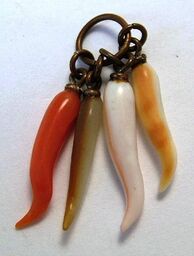 Cornetto The cornetto, shaped like a horn or chili pepper, is still popular in Southern Italy around Naples, Calabria and in the rest of Mezzogiorno (southern Italy). In Calabria and Naples this charm is worn as jewelry, hung on rear view mirrors, hung in shop windows, on key rings, and on t-shirts. It is more effective if it is red (representing an enemy's blood) and topped with a crown (representing wealth). The cornetto is a symbol of virility (obvious with its phallic shape), but it also brings luck, wealth, success and can also used by women. A similar magical horn of plenty was carried by the Roman Goddess Abundantia to represent abundance, and many think the cornetto has its roots in ancient Roman times.  Mano Corno An alternative to the cornetto, some claim the Mano Corno can ward off the malocchio (evil eye). However, in Italy, the Mano Corno can be seen as offensive... this hand gesture is called cornuto, or a cuckolded man. Give this hand sign to an Italian man and you are basically calling him weak, pathetic and unmanly. This sign--along with sticking up a middle finger--are the most insulting signs you can insult an Italian man with. This charm directly insults the devils and his demons himself.  Coccinella The Coccinella, or ladybug (ladybird) charm brings luck in the arena of love and romance. it's a very common charm in Italy, especially with women. The red color has multiple meanings... red represents victory over one's enemies (spilling their blood); red helps ward off malocchio; and red also is the color of passion and romance. Another fact about the ladybug is they eat the bad bugs who would eat a farmer's crops, so of course they came to be thought of as a sign of good luck, helping prevent crop failure.
 When I was a kid, we would occasionally find a garter snake living in our small urban garden along with our collection of 15 box turtles. I always loved snakes... smooth, silky, muscular and graceful. On our country property today, I've often seen several species of snakes: garter, ribbon, black rat. The hill behind our home is called Rattlesnake Hill, but I've never seen one. I still find it interesting when I come across snakes... but I don't honor them in any way and couldn't dream of anyone holding a festival for them! 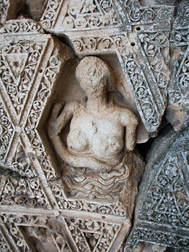 Ancient Roman temple to Angitia Ancient Roman temple to Angitia Yet, each year in the beginning of May, in the small towns of Cocullo and Villalag0, La Festa dei Serpari is held. The festival is held in honor of Saint Dominic, protector of toothache, reptile bites and rage. But the festival also has ancient pagan roots in honor of the Oscan healer and snake goddess, Angizia. Also known as Angitia to the ancient Romans, she was revered by the Marsi, a warlike tribe of people who lived to the east of Rome in the Apennine Mountains. 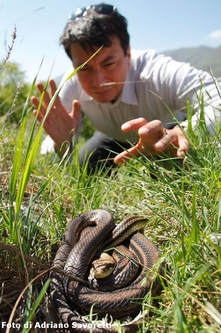 Separi reaching for his catch Separi reaching for his catch Angizia possessed an ability to heal those who had been poisoned--especially by snakes--and had the power to kill serpents by casting verbal spells. First century Romans knew the Marsi region contained many healers, magicians, and snake-charmers was infamous as a hotbed of witchcraft. The Festa dei Separi honors the modern-day separi (snake wranglers), with many of them catching and contributing snakes to the festivities. In preparation for the Festival, during the last half of March, the separi spread out across the countryside in their hunt for snakes. Once captured, they are carefully stored in wooden boxes, or as in ancient times, inside terracotta containers for 15-20 days. The snakes are fed a healthy diet of live mice and hard-boiled eggs. 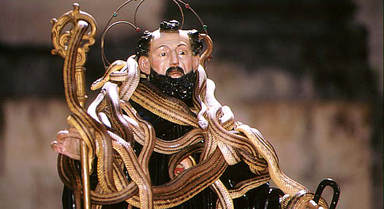 On the day of the festival, pilgrims gather in the church of San Domenico to be healed. After Mass, the statue of the Saint is draped with live snakes and carried into the piazza where believers gather to touch both the Saint and the snakes for their healing powers. The local separi also drape themselves with snakes and follow the procession. In years past, the snakes were killed afterwards and eaten in a feast, but now the bread is substituted, formed into various snake shapes... interlocking rings of snakes, biting their tails, or as serpents with sliced almond scales and coffee bean eyes. The snakes are no longer killed, but released back into the wild when the festival is over.  Some other scholars argue that the festival dates back even further to the Greek hero and god, Hercules. Supposedly, jealous Hera sent two snakes to kill him in his crib. The infant Hercules was unusually strong and fearless and strangled the snakes before they could strangle him. In the nearby hamlet of Casale votive bronzes representing Hercules have been found. Saint Domenico himself is particularly revered in Cocullo because some personal relics are kept in the church there: a molar and a horseshoe from his mule. Villalag0 also has one of his molars. There is no telling who has the rest of his teeth. Perhaps they were eaten--by snakes. --GVI  When considering a visit to the Sistine Chapel and Vatican Museum tour, perhaps you've had doubts about the long lines, heat, the expense, hours on your feet slugging through the 5 miles of museum corridors, shoulder-to-shoulder with the cruise ship tour groups, trying to soak in all of the Sistine Chapel's majesty within the 10 minutes they allow... well, you may now have a serious option for enjoying the art of the Master in a unique and new way... Artainment Worldwide Shows, along with the expertise of the Vatican Museums, have produced Giudizio Universale's Michelangelo and the Secrets of the Sistine Chapel. The multimedia and live performance show aims to be an important event for art lovers and will be a must-see for the millions of Italian and international visitors who place Rome and the Vatican Museum at the top of their Must See List. Conceived by Marco Balich, the show is the first example of an innovative format that combines the narrative of the origin of a masterpiece with the most sophisticated and technologically advanced instruments of live entertainment. For this project, Marco Balich has collaborated with world-renowned musician Sting, who composed the original theme music. The other names of the cast are stunning: the voice of Michelangelo will be by Pier Francesco Favino (known for the Disney fantasy “The Chronicles of Narnia – Prince Caspian” and the collaboration with the Oscar-winning director Ron Howard’s “Rush” and “Angels and Demons”). Together with the original theme performed and arranged by Sting, there will be new music composed by John Metcalfe, a leading figure in the contemporary pop-rock scene and producer of artists such as Morrisey, Blur and Coldplay. The show explores more than just the Sistine Chapel, but the history and works of the Master himself--Michelangelo and the 16th century Renaissance. The show is a mix of art history, theatrical performance, both photographic and physical special effects, words, images, dance and music.  The most impressive thing about the production are its 270° immersive projections, together with larger-than-life stage effects and live performances similar to Cirque du Soleil acrobatics. During a 60-minute show, spectators will follow the story of the origin of Michelangelo’s masterpiece, from Giulio II‘s commission of frescoes of the vault to the realization of the Universal Judgment, through a reenactment of the Sistine Chapel as the place for the papal election. Through the storytelling about Michelangelo, modern special effects will animate the frescos of the Sistine Chapel to end with the wonderful Universal Judgment that will come to life throughout the space around the public. A new chapter of the Italian cultural offering, Giudizio Universale is a long-term project with a typical Italian style. It will run from March 15, 2018, at the Auditorium della Conciliazione in Rome. The audience will be able to choose to attend the show in Italian or in English (starting March 24). Let's hope that the production draws away some of the crowds that are overburdening the Vatican Museum itself... and that the Vatican helps to publicize the show. It's become obvious the Vatican has oversold both the Museum and St. Peters Basilica with a fear that they are destined to become a tourist destination with as little passion and meaning as a visit to Euro Disney. From the Mouth of the Bocca: This is a great option for people who normally would never spend an entire day in a hot, stuffy art museum and prefer lighter entertainment. --Jerry Finzi |
On AMAZON:
|



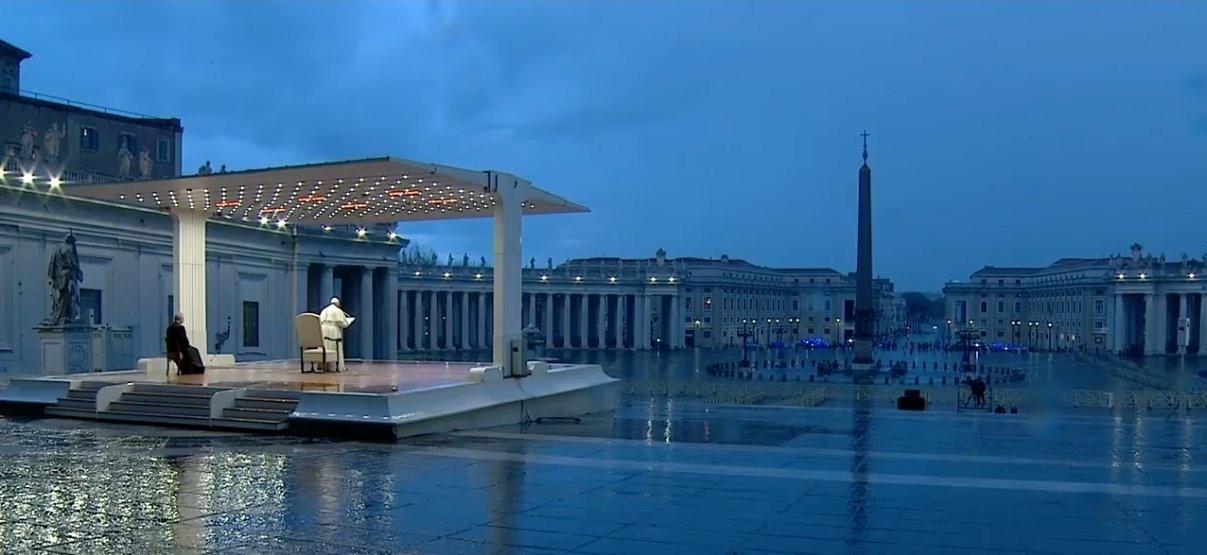

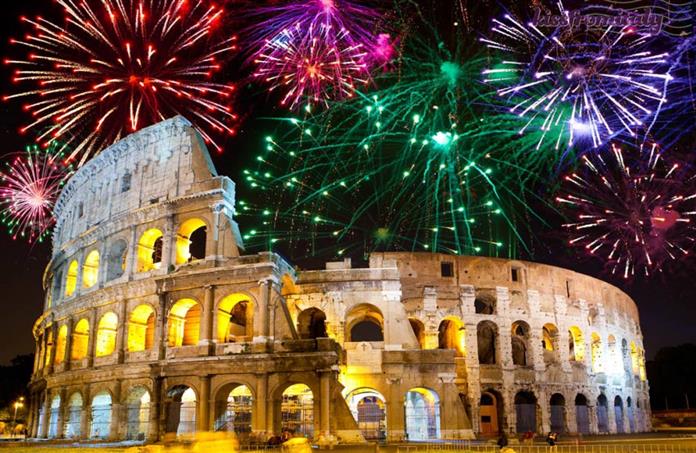

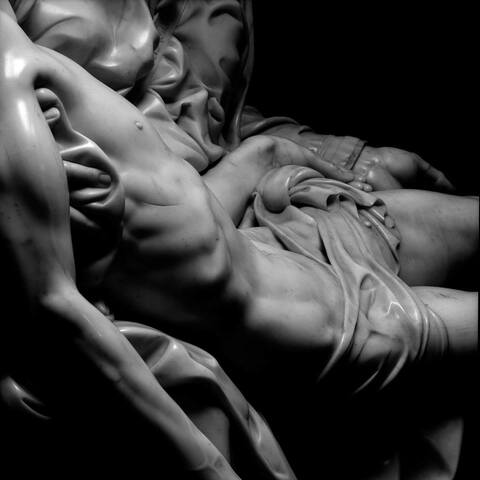
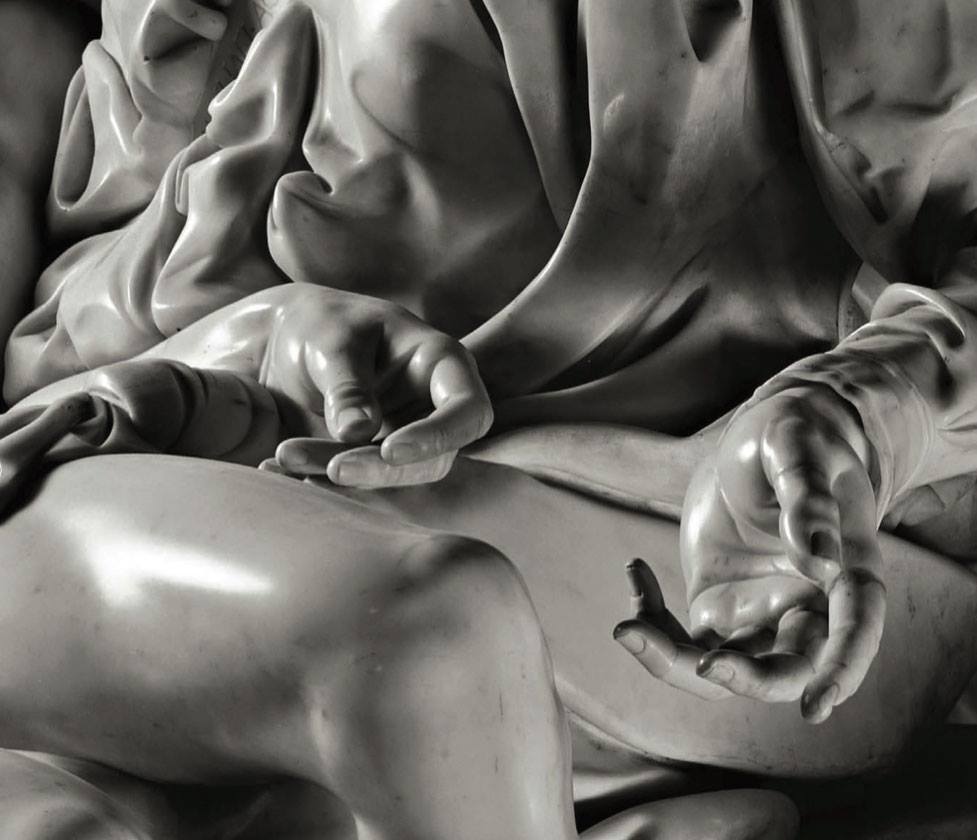

















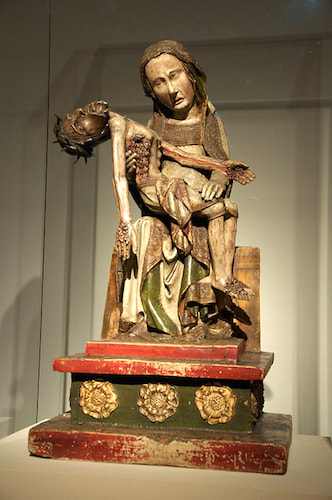

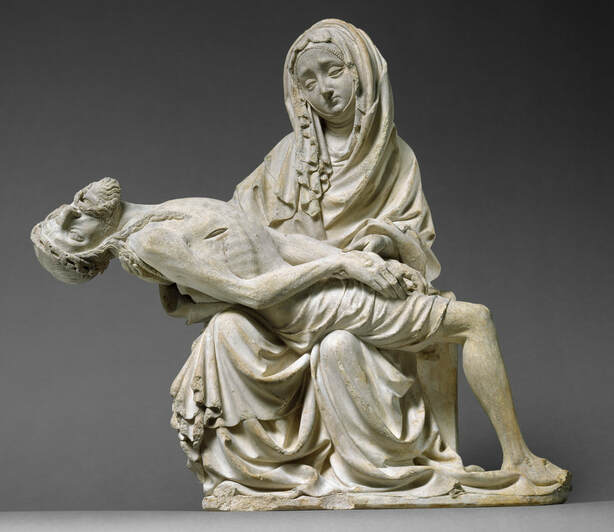


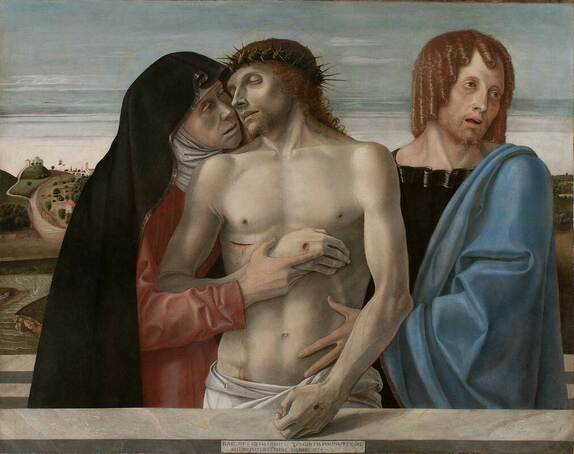









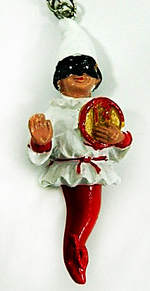


















 RSS Feed
RSS Feed

